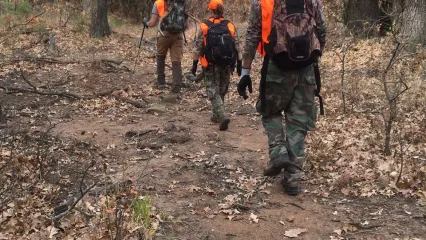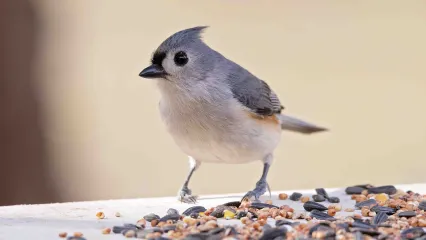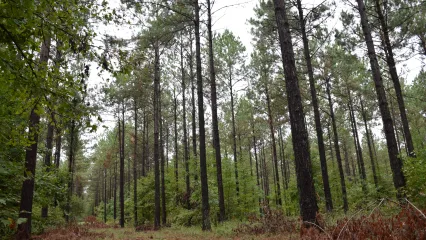Attention Non-Residents
The Oklahoma Wildlife Conservation Commission adopted new rules in 2025 that require non-residents accessing certain Oklahoma public hunting and fishing areas to check in and out of the area. By checking in and out of these areas, hunters, anglers, shooters, birdwatchers, hikers and any other users can help the Wildlife Department better understand how the area is being used. There is no additional cost associated with checking in or out of an area. There is no limit to the number of check ins for an individual in a year.

Wister WRP covers 1,000 acres of central Leflore and eastern Latimer Counties in southeastern Oklahoma and is part of the Wister WMA. The average annual precipitation for the area is about 50 inches.
Independence Entrance
From Heavener: 5 miles west on Independence Rd.
Conser Landing Entrance
From Hodgen: 5½ miles west on Conser Rd, 1 mile north on CR4695.
Potts Landing Entrance
From Wister: 2 miles east on U.S. Hwy 270, 2 miles south on Glendale Rd, 1 mile west on Potts Mt. Rd.
Britton Bottom Rd Entrance
From Wister: 2 miles east on U.S. Hwy 270, 1½ miles south on Glendale Rd, 1 mile west on Britton Bottom Rd.
Pocahontas Rd Entrance
From Wister: 2 miles west on U.S. Hwy 270, 1½ miles south on 295th Ave (CR149), 1 mile west on Pocahontas Rd, turn west at “Y” and continue ½ mile to WMA sign.
Cedar Creek Rd Entrance
From Wister: 9 miles west on U.S. Hwy 270 (½ mile west of Fanshawe), ¼ mile south on N4550.
Waits Ln Entrance
From Wister: 6 miles west on U.S. Hwy 270, 5.2 miles south on U.S. 271, at 4-way intersection go ½ mile east on CR154 to community of Summerfield, 2.7 miles south and east on Summerfield-Reichert Rd, north on Waits Ln. Rd at WMA sign.
Falls Hole Ln Entrance
From Wister: 6 miles west on U.S. Hwy 270, 5.2 miles south on U.S. Hwy 271, at 4-way intersection go east on CR154 for 1.2 miles to Falls Hole Lane and WMA sign.
- Deer: White-tailed deer are present in good numbers but are highly sought after.
- Turkey: Eastern wild turkeys are present in good numbers but are highly sought after.
- Waterfowl: Ducks are usually present in good numbers during the annual migration.
- Rabbit: Cottontail and swamp rabbits are present in good numbers.
- Squirrel: Fox and gray squirrel are present in good numbers.
- Furbearers: Bobcats, coyotes, raccoon, beaver, skunk, opossum, river otter and fox are available.
- Quail: Bobwhite quail are present in low numbers around agricultural fields.
- Dove: Dove may be present in small numbers during the annual migrations.
- Bear: Present, low numbers.
- Bald and Golden Eagles: Found on area during winter months (November - February).
Planned control burning of 2,000 acres annually, strip disc, food plots and brush hog 500 acres annually,14,000 acres control grazing operation. Management efforts focus on maintaining openings, controlling woody vegetation to improve existing habitat for wildlife species present.
Primitive camping sites are offered throughout the WMA. Two concrete boat ramps are available on the Poteau river portion of the WMA Modern camp sites and cabins are available at nearby Wister Lake State Park. Wister Lake State Park can be reached at (918) 655-7756.
Good fishing opportunities exist at the 7,000 acre Wister Lake, particularly for catfish and crappie. The Poteau River above Wister Lake is also a good area for springtime runs of white bass.
All shotgun hunting is restricted to federally approved nontoxic shot.
Closed Seasons
Seasons w/ Special Restrictions
- Bear Archery, Deer Archery, Dove, Rail, Gallinule, Quail, Crow, Rabbit, Squirrel, Turkey Fall Archery, Pursuit with Hounds for Furbearers, Predator/Furbearer Calling, Duck, Merganser and Coot
Closed from Oct. 15 - Jan. 31.
- Turkey Spring, Youth Turkey Spring
One-tom limit; seasons combined.
Public access is prohibited from Oct. 15 - Jan. 31.
No camping allowed.
Kiamichi Country Tourism
1-800-722-8180
Heavener Chamber of Commerce
501 West First St, Heavener 74937
(918) 653-4303
heavenercofc@leflorecounty.com
Oklahoma Tourism and Recreation Department
Post Office Box 52002
Oklahoma City, OK 73152-2002
(800) 652-6552 or (405) 521-2409
www.travelok.com
Poteau Chamber of Commerce
200 South Broadway, Poteau 74953
(918) 647-9178
Talihina Chamber of Commerce and Ouachita National Forest Interpretive Association
900 Second St, Suite 12, Dept 03,
Talihina, OK 74571
(918) 567-3434
www.talihinacc.com
vera@talihinacc.com
Apprentice Designation: A Learner's Permit for Hunting
Hunter education has greatly reduced hunting accidents, but if you can’t complete a course right away, the apprentice designation allows you to hunt under supervision. It works like a learner’s permit, giving you the chance to gain real experience safely until you finish hunter education.
Exploring the New Herron Family WMA
The new Herron Family WMA is more than 17,000 acres of hunting land, it is also adventure, access, conservation, and tradition. Thanks to a unique partnership, Oklahoma residents now have a new place to chase deer, call turkeys, hear quail, and pass on the outdoors to the next generation.


